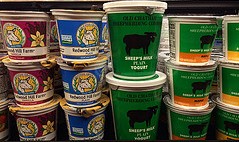I thoroughly enjoy making yogurt. But, of course, most yogurt is made of cow’s milk.
I was able to find some goat and sheep milk yogurts in my local store. They were good. Interestingly, the sheep milk yogurt had the stronger flavour, which made it better to cook with than to have cereal or fruits with. And, of note, both yogurts had the same consistency as cow milk yogurt due to fancy thickeners and food production techniques of commercial products.
I also was able to find goat milk in my local store, with which I made a batch of yogurt. The consistency was different from my cow milk home-made yogurt, a bit more runny, but more cohesive. Though I think this is partly due to my production technique, which I have since improved.
In my past few batches of cow milk yogurt, I’ve improved my temperature control and have been getting a consistent product that I like. So now I am bent on doing another batch of goat milk yogurt to see if I can improve the consistency (I’ve been looking for wholesalers nearby). Also, I’ll probably use a starter from goat yogurt, rather than my usual cow milk yogurt starter, in case there are some differences in the strains that produce the better goat yogurt.
There’s more
I’ve also been pondering milk from other animals. For example, I was talking to an alpaca breeder. I got all excited and asked if he had any milk. He laughed and told me that when you try to milk an alpaca, she’s not too happy and actually lays down.
So no milk there.
And today, while reading up on difference between goat and cow milk, I stumbled on a nice article on camel and buffalo milk. Go read the article, as it has a nice cultural discussion of the different milks.
I’ve also reproduced below a really great table she had comparing different milks (no sheep, though).
What different milks have you had?
|
|
Cow
|
Goat
|
Buffalo
|
Camel
|
|
Cholesterol
|
Higher than buffalo or camel milk
|
Higher than buffalo or camel milk
|
Lower cholesterol than cow or goat milk
|
Lower cholesterol than cow or goat milk
|
|
Vitamins and minerals
|
Higher fat and protein than human milk
|
Low in B6 and B12, higher in calcium than cow milk
|
Similar to cow’s milk, although higher in calcium
|
3 times higher in vitamin C than cow’s milk, 10 times higher in iron but less vitamin A and B2
|
|
Protein
|
3.29%
|
3.56%
|
4 %
|
2.2-5%
|
|
Cross reactivity of milk protein
|
Casein antibody cross-reactivity with goat and cow. 2-3% infants allergic to milk proteins.
|
Similar casein structure to human milk and different from cow. Those allergic to cow milk might also be allergic to goat milk in about 25% of the cases
|
Some protein antibody cross-reactivity with goat and cow. One case of Buffalo milk tolerance when allergic to cow milk
|
Little or no cross-reactivity between cow and camel milk proteins. This indicates that those allergic to cow milk can drink camel milk.
|
|
Lactose
|
4.7%
|
4.1%
|
4.8%
|
4.8%
|
|
Fat
|
1-3%
|
3-6%
|
7-8 %
|
3-5%
|
|
Fat characteristic
|
Needs to be homogenized otherwise fat rises to the top, large fat molecules have a tendency to clump
|
Larger number of small fat molecules than cow milk, Smaller softer curd, no cream formation. Does not contain agglutinin, so the fat molecules do not clump together. Believed to be the reason why it is easier to digest. more essential fatty acids such as linoleic and arachnodonic, and higher medium chain fatty acids
|
Smaller molecules which don’t clump together like in cow’s milk. Contains lower levels of agglutinin compared to cow’s milk but has similar digestibility.
|
Does not contain enough agglutinin and therefore fat molecules do not clump together. Size of the fat molecules are similar to cows
|
|
Butter, cheese making
|
Contains agglutinin, fat separates easily, butter made by churning, cheese is made using rennet
|
Lacks agglutinin, difficult to make butter by churning, many soft goat cheeses are made without rennet
|
Traditionally used to make mozzarella in Italy, better color and texture, yogurt is thick and creamy
|
Does not contain sufficient agglutinin for efficient cream separation. Butter is made using a centrifuge. Cheese produced using camel rennet, vegetable rennet has been used with limited success. Easily made into yogurt
|
|
Health
|
Good source of calcium and vitamin D
|
More easily digested because of smaller fat size and distribution characteristics. It is also alkaline. Better tolerated with those with lactose intolerance.
|
Low in cholesterol, good source of nutrients such as calcium and other vitamins and minerals
|
Used to treat type 1 diabetes (contains insulin like molecules), strengthens cellular immune response, high in lactoferrin, which has antimicrobial activity, reduces allergic response in children
|
|
Problems
|
Linked to milk allergies and intolerance ranging from atopic dermatitis, diarrhea, and constipation.
|
Not appropriate for those who have severe lactose intolerance, although usually tolerated better than cow’s milk
|
Contains lactose so may be a problem with those suffering with lactose intolerance
|
Contains lactose so may be a problem with those suffering with lactose intolerance, although better tolerated than cow’s milk
|
|
Flavor
|
|
Flavor can be strong in comparison
|
Similar to cow milk
|
Sweeter than other milks
|
